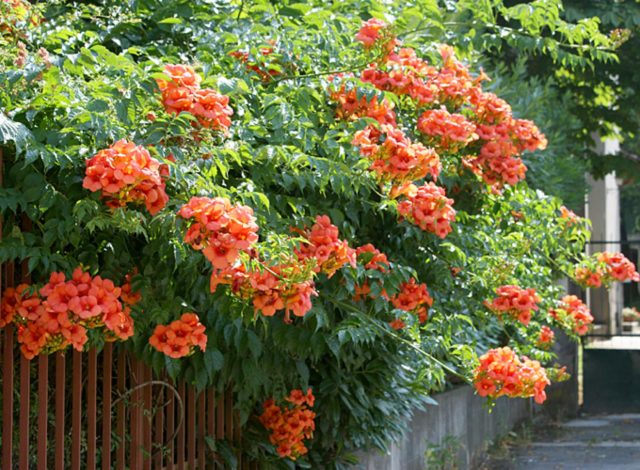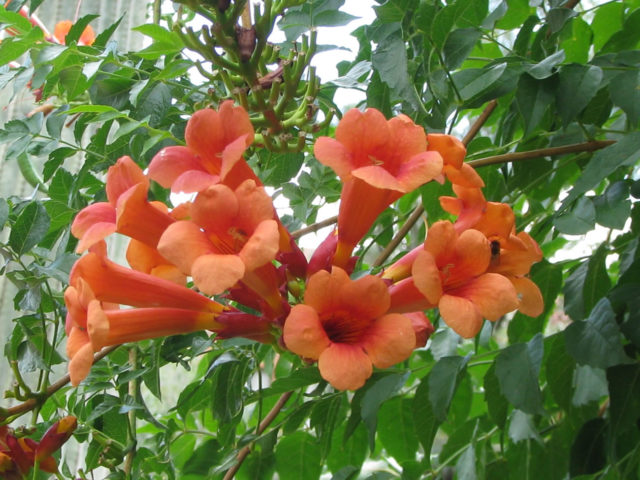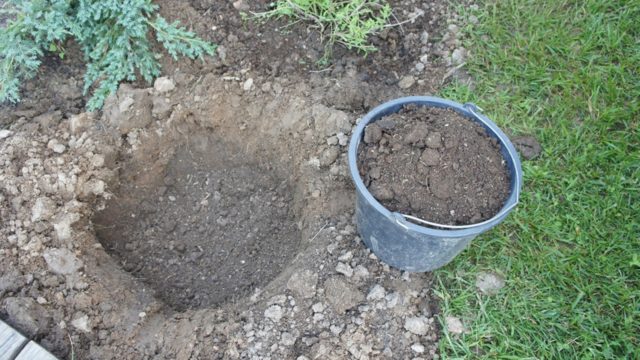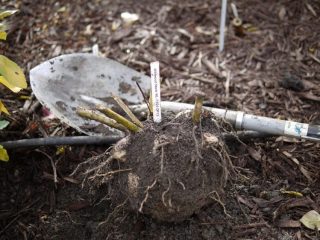Content
Campsis is a perennial flowering vine that belongs to the Bignoniaceae family. The birthplace of the culture is considered to be China and North America. The plant is ideal for vertical gardening, is undemanding in care and has high frost resistance, which allows it to be grown in the middle zone. But planting and caring for Kampsis in the Moscow region should be carried out taking into account the climate of this region and the requirements of the vine. Only in this case will the perennial fully develop and delight with long-lasting flowering.

Campsis is also called bignoia
Features of growing Kampsis in the Moscow region
The plant is characterized by creeping shoots, the length of which can reach 14 m, but in the conditions of the middle zone does not exceed 8 m. Initially they are flexible, but as they grow they become lignified. When growing Kampsis in the Moscow region, the vine must be insulated for the winter, so this should be taken into account when planting.
The shelter must be removed at the end of April. If the time is delayed, the shoots of the plants may become warm, and if removed early, they may freeze.
Suitable varieties
Not all types of campsis are suitable for cultivation in the Moscow region, but only rooted and hybrid ones. For conditions in the middle zone, you should choose varieties bred on their basis. They are characterized by increased resistance to frost and temperature changes.
Suitable varieties for the Moscow region:
- Flamenco. The variety is distinguished by climbing shoots on which sucker roots are evenly distributed. Their length reaches 8-10 m. The annual growth is 1.0-1.5 m. The leaves are large, up to 20 cm. The plates are a rich green shade, and the reverse side is light. The flowers of this variety of campsis reach a length of 9 cm and their diameter is 5 cm. Their hue is bright orange.
The Campsis variety Flamenco blooms at the end of July and continues until October.
- Early. This variety, as can be understood from the name, blooms a month earlier than the others. The first buds on the vine in the Moscow region appear in the second half of June. The color of the flowers is bright red. Their length reaches 10-12 cm, and their diameter when opened is 8 cm.
The length of the shoots of the Kampsis variety Early is 6 m
- Flava. This type of vine grows no more than 8 m in the middle zone. A special feature of this variety is its light yellow flowers. Their length is 9-10 cm, and their diameter is 4-5 cm. The variety was obtained in 1842.
The variety Flava was awarded a prize in 1969 by the English Gardening Club
Planting and caring for Kampsis in the Moscow region
Campsis is an unpretentious plant that does not require special attention from the gardener.To obtain long and abundant flowering in the conditions of the Moscow region, it is necessary to properly plant and provide minimal care, consisting of watering, fertilizing, pruning and shelter for the winter. Therefore, you need to familiarize yourself with the rules for carrying out these agricultural activities.
Recommended timing
It is necessary to plant Kampsis in the Moscow region when the soil has warmed up well and the threat of return frosts has passed. The optimal period for this region is considered to be the end of May and the beginning of June.
Carrying out the procedure earlier may cause the seedling to freeze. And if the deadlines are delayed, this will lead to active vegetation of the vine, which will prevent rooting.
Site selection and preparation
It is necessary to prepare the site for planting campsis at least 10 days in advance. It is best to do this in the fall if possible. To do this, you need to dig it up and add it to each square. m. 10 kg of humus.
Then you should dig a planting hole 70 cm deep and 60 cm wide. Lay broken brick 10 cm thick at the bottom. And the remaining 2/3 volume must be filled with a nutrient substrate of turf, sand, peat and leaf soil in a ratio of 2:1:1 :1. You should also additionally add 40 g of superphosphate and 30 g of potassium sulfate and mix everything thoroughly. In this form, the pit must stand for at least 10 days so that the soil has time to settle.
Landing algorithm
The landing procedure in the Moscow region is no different from other regions. Therefore, it must be carried out according to the standard scheme.For this purpose, it is best to purchase seedlings that are 2-3 years old, since they have already become sufficiently strong and have developed a root system, which will allow them to quickly adapt to a new location.
Procedure for planting Kampsis in the Moscow region:
- Make a slight elevation in the hole.
- Spread the roots of the seedling and shorten them by 1/4.
- Place the seedling on a hill without deepening the root collar.
- Cover the roots with soil and carefully fill all the voids.
- Compact the soil surface at the base.
- Water generously.
The day after planting, it is necessary to mulch the root circle of the Kampsis with straw or peat to retain moisture in the ground.
Watering and fertilizing schedule
Campsis does not tolerate too much or too little moisture. Therefore, it is recommended to water only during a long absence of rain in the Moscow region. Moisturizing is required when the soil dries 5 cm deep. When watering, use water at a temperature of + 20 °C.
Due to the abundant flowering of Campsis liana, fertilizing in the Moscow region should be carried out twice per season. Fertilizers must be applied for the first time in the spring during the active growth of shoots. During this period, you can use organic matter or nitrogen mineral fertilizers. The second time is when the buds are forming. At this time, phosphorus-potassium mixtures should be used. These components improve the color intensity of flowers and increase frost resistance.
Installation of supports
When planting Kampsis in the Moscow region, you must immediately worry about support for the vine.The peculiarity of this plant is that during the growth process its shoots firmly adhere to the structure, and it is unlikely that they will be removed later. Therefore, it is necessary to select a support that can easily withstand the load. And at the same time it can be used as a frame for shelter.
Weeding and loosening
During the season, it is recommended to remove weeds that grow in the root circle of the campsis, as they take moisture and nutrients from the soil. It is also important to loosen the soil after each moistening to maintain air access to the roots of the plant.
Trimming
The liana needs to be trimmed periodically to maintain its decorative appearance. In the conditions of the Moscow region, the plant should be formed into 2-4 shoots. They will perform the main function. And the rest must be cut at the base. In autumn, the lateral shoots should be adjusted, leaving them no more than 2-3 buds long.
Throughout the season, it is recommended to mercilessly cut out all young growth at the base of the campsis.

Liana blooms on the shoots of the current year
Preparing for winter
In the Moscow region, Kampsis should be covered for the winter. In late autumn, it is important to remove young seedlings from their support, lay them on the ground and cover them with spruce branches and then with agrofibre.
Overgrown specimens must be sprinkled with soil at the base, compacting it. And after trimming, wrap the upper part with spandex directly on the support in several layers.
Pests and diseases
Campsis in the Moscow region exhibits high resistance to diseases. The plant can only suffer from root rot when there is stagnation of moisture. Therefore, you need to choose the right place and control watering.
Of the pests, only aphids can cause damage to the plant. It feeds on the juice of young shoots and leaves. Therefore, when a pest appears, the vine should be treated with Confidor Extra.
Conclusion
Planting and caring for Kampsis in the Moscow region has its own characteristics due to the climatic conditions of the region. But growing the plant does not present any difficulties even for gardeners who do not have many years of experience. Therefore, in the ranking of climbing crops, Kampsis occupies a leading position, because few plants of this type combine unpretentiousness and long flowering.














